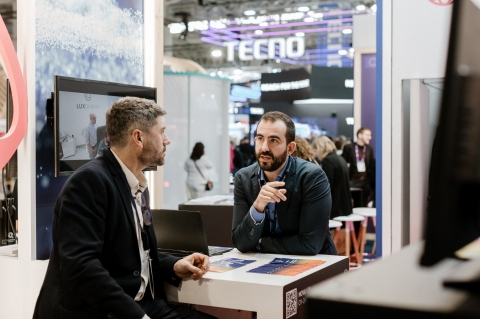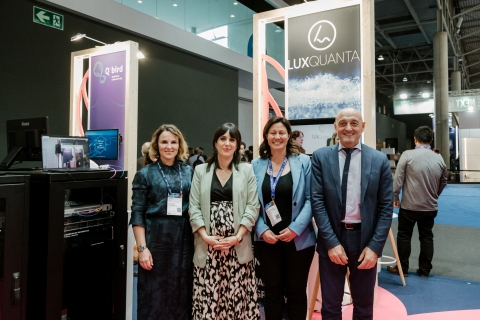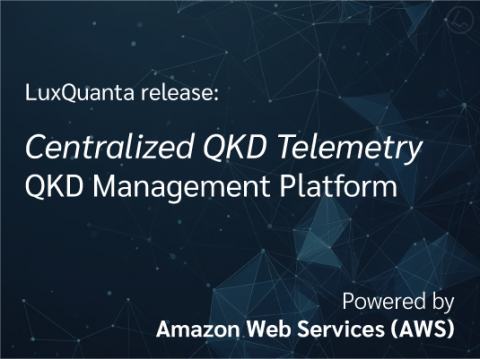Multi-vendor QKD demonstration: LuxQuanta at EQTC Hannover '23
LuxQuanta was a part of a multi-vendor QKD demonstration showcased at the European Quantum Technology Conference (EQTC) in Hannover, simulating a "mini-EuroQCI" deployment. Throughout the event and exhibition, a live video conference was consistently encrypted using quantum-generated keys from the QKD system.
From October 16th to 20th, 2023, Quantum Valley Lower Saxony hosted the highly anticipated biannual event at the prestigious Hannover Fairground, drawing a distinguished assembly of professionals and experts in the field.
This initiative, led by the Coordination and Support Action (CSA) for the European Quantum Communication Infrastructure (EuroQCI), PETRUS, aimed to demonstrate the current state of technology maturity and its significance in securing Europe's most critical data to the industry and European decision-makers. In collaboration with participants from the DIGITAL program "EU Secure Quantum Communication Infrastructure (DIGITAL-2021-QCI-01)" and a dedicated local team, the demonstration of QKD's groundbreaking capabilities was a success.
It also highlights the necessity for collaboration among different technologies and the importance of interoperability between QKD manufacturers.
 The two racks containing all the systems. In the left rack, all the Transmitter modules were placed, while the Receivers were in the right one
The two racks containing all the systems. In the left rack, all the Transmitter modules were placed, while the Receivers were in the right one
THE COLLABORATION
o achieve this ambitious goal, the demonstration brought together a collaborative effort of pivotal contributors in the Quantum Ecosystem.
Four QKD vendors, each utilizing distinct technologies, united their strengths to enable interoperability among systems in the demonstration. Among these providers, LuxQuanta introduced its Continuous Variable QKD System, NOVA LQ®. ThinkQuantum, QTI, and Quantum Optics Jena contributed Discrete-Variable (DV-QKD) and Entanglement-based QKD technologies.
 Representants of all companies involved in the demonstration at the booth.
Representants of all companies involved in the demonstration at the booth.
The quantum-generated keys were managed by the Stack SDN KMS software solution developed by the Polytechnic University of Madrid (UPM). This software efficiently interconnected the various technologies and delivered the keys to Rhode & Schwarz encryptors to ensure the security of the videoconference. Telsy provided the software used for the video conference.
Furthermore, companies from the PETRUS consortium actively participated in the demonstration, which included notable organizations such as Airbus, Ericsson, Deutsche Telekom, AIT, and Thales. This collaboration brought together a unique assembly of industry leaders in the quantum-related sector, all dedicated to realizing the EuroQCI objective.
| EuroQCI | The EuroQCI will safeguard sensitive data and critical infrastructures by integrating quantum-based systems into existing communication infrastructures, providing an additional security layer based on quantum physics. It will reinforce the protection of Europe’s governmental institutions, their data centres, hospitals, energy grids, and more, becoming one of the main pillars of the EU’s Cybersecurity Strategy for the coming decades. The EuroQCI will make use of innovative quantum communication technologies. The initiative will thus contribute to European digital sovereignty and industrial competitiveness, and help to meet Europe’s Digital Decade target of being at the cutting edge of quantum capabilities by 2030. |
TOPOLOGY ARCHITECTURE
The demonstration, more intricate than the one showcased at the Stockholm DIGITAL Assembly in June, incorporated two additional QKD vendors. The topology was configured with three nodes, featuring two parallel QKD links connecting node 1 and 2, as well as two more linking 2 and 3.
In this setup, the SDN KMS Stack Software from the UPM efficiently oversaw the keys from all vendors and transmitted them to the Rhode & Schwarz encryptors. These encryptors were responsible for securing the video conference through encryption.
.png)
MULTI-VENDOR APPROACH
This multi-vendor configuration demonstrated the practicality of interoperability among diverse QKD technologies and provided a concrete use case for securing communications.
The various types of QKD technology, namely DV-QKD, CV-QKD, and EB-QKD, exhibit distinct characteristics and are best suited for different scenarios. Ensuring effective interoperability between these technologies and implementing a mature and efficient SDN (Software-Defined Networking) and KMS (Key Management System) for orchestrating the network architecture is essential when deploying QKD links in real networks with diverse requirements.
This serves as an illustrative example of the technology's potential, not only within the context of EuroQCi initiative deployment but also in various network environments.
LuxQuanta’s CV-QKD System: NOVA LQ®
LuxQuanta contributed its Continuous-Variable Quantum Key Distribution System to the demonstration. NOVA LQ® stands out as one of the initial commercially available CV-QKD systems in Europe and represents the company's pioneering system in this field.
This system is entirely constructed using mature telecommunication components. Thanks to its continuous variable technology, it can be seamlessly integrated into already deployed optical fibers, allowing the co-propagation of quantum signals with classical communications, all without the necessity of a dedicated dark fiber.
Continuous-Variable technology employs highly attenuated lasers to encode the essential information required for key generation within the quadrature of the light. This encoding involves both the phase and amplitude of the light, eliminating the need for dedicated components such as single photon detectors
 LuxQuanta's NOVA LQ® CV-QKD System below the servers of the UPM containing their Stack SDN KMS.
LuxQuanta's NOVA LQ® CV-QKD System below the servers of the UPM containing their Stack SDN KMS.
THE ORCHESTRATOR: Stack SDN KMS from the University of Madrid

THE EVENT: A CRITICAL SHOWCASE OF THE TECHNOLOGY MATURITY
Every two years, the Quantum Flagship brings together major European research and innovation networks at the European Quantum Technology Conference (EQTC). This event, being the largest of its kind, serves as a platform to celebrate breakthroughs, showcase the pioneering work of European organizations, and foster connections within the quantum community.
The EQTC encompasses all the scientific and technological pillars of the Quantum Flagship and the European ecosystem, as well as select global advancements. It stands as the premier event for gaining insight into the European ecosystem and staying at the forefront of developments.
As a result, it provided an ideal space to present the true state of maturity of QKD, conveying to attendees and the European Commission the critical importance of quantum-securing our communications.
Throughout the conference, notable figures dedicated to Europe's Quantum Development within the European Commission visited the demonstration to witness the multi-vendor topology in real-time. Key personnel like Gustav Kalbe, Head of Unit of Quantum Technologies, and Oscar Diez, Head of Quantum Computing and Technologies, also attended to learn more about the demo and observe an architecture resembling a "mini-EuroQCI," signifying the advanced maturity level of QKD technology.
 At the right, Oscar Díez, European Comission's Head of Quantum Computing and Technologies, talking with Felix Wissel from Deutsche Telekom.
At the right, Oscar Díez, European Comission's Head of Quantum Computing and Technologies, talking with Felix Wissel from Deutsche Telekom.
Technology Sessios: Dr. Etcheverry, CTO & co-founder of LuxQuanta, about CV-QKD
During the Quantum Communications sessions, Dr. Sebastian Etcheverry, CTO, and co-founder of LuxQuanta, delivered a presentation on the technology behind NOVA LQ®. He conducted an in-depth exploration of the inner workings of Continuous Variable QKD and elucidated the foundational elements of our system's unique value proposition.
Dr. Etcheverry's presentation captured the attention of a broad and engaged audience, and many curious attendees approached him afterward with technical inquiries.
Our commitment to disseminating high-value technical information is of utmost importance to us, serving both the industry and academia. We take pride in developing our products with a robust and cutting-edge scientific foundation.


Left Image. Dr. Etcheverry answering questions after the presentation to many interested attendees. Right Image. Sebastian speaking in forn of the audience.


